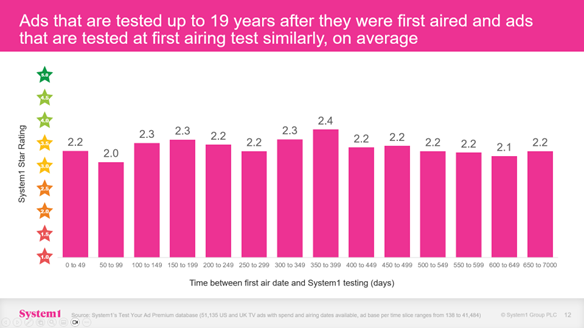Reused ads, or those using recurring elements, are scoring extremely well
Repeating existing ads and reusing existing characters at Christmas is a highly effective strategy, according to new evidence from System1, who test every Christmas ad every year on their Test Your Ad platform. That tallies with existing studies into “Wear-Out” from System1, which show that wear-out (ads losing effectiveness over time) is largely a myth, and that many ads are actually more likely to ‘wear in’.
RECURRING XMAS CHARACTERS AND ADS ARE HIGHLY EFFECTIVE
In recent years we’ve seen a growing trend at Christmas for brands like M&S and Aldi to use recurring characters in their annual Christmas ads. This year that’s been joined by brands re-using not just characters but ads, with Cadbury and the National Lottery running their 2022 ads again.
Our tests show that for the examples we’ve seen in 2023, this strategy is highly effective. Test Your Ad uses real consumer emotional response to predict the long- and short-term effectiveness of advertising. Its Star Rating, which runs from 1.0-Star to 5.9-Stars, predicts an ad’s potential to help long-term brand growth: only 1% of TV ads overall rate 5-Stars, but the number at Christmas time is far higher as brands run more ads people enjoy.
Here are the ads using recurring elements we’ve seen outperform the market in 2023:
- Aldi brought Kevin The Carrot back for the eighth time and again scored a 5.9–Star maximum on Test Your Ad. Every year for the past five years Aldi ads featuring Kevin the Carrot have been 5-Star ads.
- M&S Food brought back their M&S Fairy, voiced by Dawn French, for the third year running and achieved their first maximum, 5.9-Stars, on Test Your Ad.
- The National Lottery re-released their 2022 ad, directed by Oscar-winning Tom Hooper, about a romantic encounter on a train. Last year it scored 5.7-Stars and this year it stayed in the elite 5-Star bracket with 5.1-Stars.
- Cadbury re-released their 2022 ad in their Secret Santa campaign, and it scored 5.3-Stars this year after scoring 5.2-Stars last year.
- Coca-Cola are running their “Holidays Are Coming” ad again this year. System1 retested the most recent creative in the 28-year-old campaign and it scored a maximum 5.9-Stars once again.
- Duracell have returned to Christmas advertising with their iconic Duracell Bunny character and scored a 5-Star ad.
“Traditionally brands have felt pressure to come up with something new at Christmas.” said Jon Evans, System1 Chief Customer Officer, “Each Christmas we give them our hearts but the very next day they give them away, scrapping 5-Star characters and ideas as soon as the season ends. But the evidence shows that effective ads and characters are effective every year, with 5-Star ads retaining their effectiveness when re-used. Christmas ads don’t usually wear out, and festive characters actually wear in. Neither M&S Fairy or Kevin The Carrot scored 5-Stars on their first appearance – but marketers invested in them and had a long term plan, and now they’re getting our maximum score for long-term effectiveness.”
Brands are also happier now to reinvest in strong creative. Anna McInally. Head of Marketing Communications & Creative at The National Lottery, said: “We know from System1 testing and our commercial performance that ‘A Christmas Love Story’ was a highly effective ad at both building the National Lottery brand for the long term and driving sales in the short term. More people bought a National Lottery game during last Christmas than ate turkey! Creating a Christmas ad is a huge investment and so it was a no brainer to run this much-loved ad for a second Christmas”
THE MYTH OF WEAR-OUT
Christmas ads staying effective even when repeated should come as little surprise to marketers – it confirms the basic findings of a report earlier this year from System1 into The Myth of Wear-Out.
As part of this study, System1 compared the Star Rating of ads by the time since first air date. The analysis covered over 50,000 ads and went back up to 7,000 days. If the theory of wear out was true, older ads would perform worse when tested, as audiences would be more familiar with and tired of them. However the average Star scores varied little over time as the chart below shows.
Not only that, the study showed that far from wearing out – becoming less effective over time – some of the most effective ads showed wear-in: they actually increased in effectiveness as they became more familiar to audiences.
These ads tended to exhibit what Orlando Wood, author of Lemon and Look Out, describes as right-brained elements – creative elements that emphasise human interaction and context, like dialogue, gestures and glances, and a strong sense of place and time.
“The welcome trend towards highly effective ads making a Christmas comeback is more evidence for the central idea of our report” said Jon Evans, “Wear-out is a myth, and the best ads wear-in as familiarity breeds contentment. There’s little more frustrating than seeing brilliant, 5-Star ideas and characters with huge potential being scrapped just as they’re starting to work with the public. It’s a form of short termism that doesn’t make creative or financial sense. Often the boldest decision a marketer can make is to stick with what’s working and reject novelty for its own sake.”
Source: System1


You must be logged in to post a comment Login